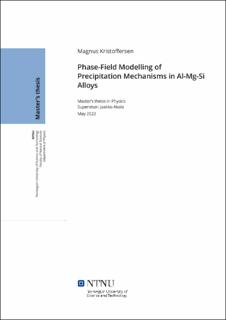| dc.contributor.advisor | Akola, Jaakko | |
| dc.contributor.author | Kristoffersen, Magnus | |
| dc.date.accessioned | 2022-10-07T17:34:33Z | |
| dc.date.available | 2022-10-07T17:34:33Z | |
| dc.date.issued | 2022 | |
| dc.identifier | no.ntnu:inspera:108350165:33638913 | |
| dc.identifier.uri | https://hdl.handle.net/11250/3024802 | |
| dc.description.abstract | Denne masteravhandlingen studerer utfellingsprosessen av β′′ utfellinger under kunstig eldning av aluminiumslegeringer i 6xxx-serien ved å benytte seg av fase-felt metoden. I løpet av de siste to tiårene har det blitt utført eksperimentelle studier der et eksternt felt ble satt på over en legeringsprøve av en aluminiumslegering samtidig som prøven var under kunstig eldning. Disse studiene oppdaget at legeringsprøvene oppnådde høyere maksimal styrke og raskere eldning under denne behandlingen. Arbeidet i denne avhandlingen ser på effekten av elektronvind på mikrostrukturen, forårsaket av at det blir satt på en elektrisk likestrøm gjennom legeringsprøven. Bidraget fra elastisk tøyning som følge av at gitterstrukturen til β′′ utfellingene passer dårlig inn i aluminiumsgitteret blir også lagt til i fase-felt modellen for å oppnå den typiske nål-formen til disse utfellingene.
Det blir beregnet en karakteristisk tidsskala for diffusjonen av temperatur i mikrostrukturen som kommer frem til at det tar t = 156 ps å propagere en temperaturfront 100 nm, og dette indikerer at temperatursvingninger kan ses bort fra i modellering av mikrostrukturen. Simuleringsresultatene tilknyttet systemet med påført elektriske likestrøm over legeringsprøven oppnår ikke de samme utviklingsmekanismene i mikrostrukturen som har blitt sett i eksperimentelle undersøkelser av lignende systemer. Dette kan indikere at bidraget fra elektronvinden utgjør lite i forhold til andre utviklingsmekanismer i legeringer. | |
| dc.description.abstract | In this master’s thesis, the precipitation process of β′′ precipitates during artificial ageing of 6xxx-series aluminium alloys is studied using the phase-field method. During the last two decades, experimental studies have been conducted with an external field across a sample of aluminium alloy during artificial ageing. These studies found that the application of an external field resulted in higher peak hardness values and shorter ageing time compared to the conventional artificial ageing process. The work in this thesis considers the effect of the electron wind on the microstructure, caused by applying a direct electric current across the sample. The elastic strain contributions due to the misfit between the aluminium host matrix and the precipitate phase is also implemented into the phase-field model to obtain the correct needle-like shape of the precipitates.
The calculation of a characteristic time scale for the diffusion of temperature in the microstructure is performed, finding that a temperature front propagates 100 nm in the course of t = 156 ps, indicating that temperature fluctuations can be neglected in microstructure modelling. The simulation results connected to the applied direct current does not attain the same evolution mechanisms as those presented in experimental studies of similar systems, which may indicate that the contribution from the electron wind in real alloys is small compared to other evolution mechanisms. | |
| dc.language | eng | |
| dc.publisher | NTNU | |
| dc.title | Phase-Field Modelling of Precipitation Mechanisms in Al-Mg-Si Alloys | |
| dc.type | Master thesis | |
